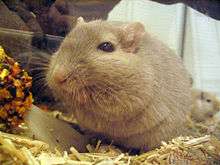Obesity in pets


Obesity in pets is common in many countries. Rates of overweight and obesity in dogs in the United States ranges from 23% to 41% with about 5.1% obese.[1] Rates of obesity in cats was slightly higher at 6.4%.[1] In Australia, the rate of obesity among dogs in a veterinary setting has been found to be 7.6%.[2] The risk of obesity in dogs but not cats is related to whether or not their owners are obese.[3]
In Australia, obesity "is their most common nutritional disease."[4] Obese dogs and cats have a higher incidence of arthritis, heart disease, and possibly urinary tract infections.[5]
Pet obesity has been enough of a concern that Pfizer developed, and obtained US Food and Drug Administration approval in 2007 for a drug, named dirlotapide (marketed as Slentrol), to treat dog obesity.[6] However, concerns have since been raised, since 2010, about adverse effects[7] that might more strongly affect particular breeds,[8]
Multiple pet owners have been prosecuted for cruelty to animals due to their dangerously obese dogs. Two British brothers were cited in 2006 for cruelty and neglect of their chocolate Labrador retriever, "who was allegedly made so obese by his owners that he 'looked like a seal' and could barely waddle a few steps".[9] Cats have also been found to suffer from morbid obesity.
The primary reasons for obesity in pets is over eating and lack of physical exercise. In wealthier countries, many can afford to give their pets excessive amounts of food. Owners view food as a way to reward and treat their pets, which contributes to their overeating habits. Modern day pet foods are a higher quality food, and some pets are prone to gorging themselves to the limit of their stomach capacity, a behavior developed through evolution. In addition, pets, especially dogs, are often not allowed to free roam as they did in the past. Pets confined to a house or small yard, or who are not regularly walked or played with, are more prone to obesity.. Research conducted by the Waltham Centre for Pet Nutrition and others has established safe weight levels and strategies for maintaining healthy body mass in cats and dogs.[10]
One study in cats has shown that surgical sterilization of animals increases the chances of the pet becoming overweight.[11]
According to the Association for Pet Obesity Prevention, 53% of adult dogs and 55% of adult cats are overweight or obese.[12][13] National Pet Wellness Month is October and National Pet Obesity Awareness Day is October 10.[14][15][16]
See also
References
- 1 2 Lund Elizabeth M. (2006). "Prevalence and Risk Factors for Obesity in Adult Dogs from Private US Veterinary Practices" (PDF). Intern J Appl Res Vet Med. 4 (2): 177–86.
- ↑ McGreevy PD, Thomson PC, Pride C, Fawcett A, Grassi T, Jones B (May 2005). "Prevalence of obesity in dogs examined by Australian veterinary practices and the risk factors involved". Vet. Rec. 156 (22): 695–702. doi:10.1136/vr.156.22.695. PMID 15923551.
- ↑ Nijland ML, Stam F, Seidell JC (June 2009). "Overweight in dogs, but not in cats, is related to overweight in their owners". Public Health Nutr. 13 (1): 1–5. doi:10.1017/S136898000999022X. PMID 19545467.
- ↑ "The Good Life". Townsville Bulletin. Australia. 2006-08-10. p. 24.
- ↑ Wynn, S. G.; Witzel, A. L.; Bartges, J.W.; Moyers, T. S.; Kirk, C. A. (March 14, 2016). "Prevalence of asymptomatic urinary tract infections in morbidly obese dogs". PeerJ. 4. 4:e1711. doi:10.7717/peerj.1711.
- ↑ Klonoff, DC (2007). "Dirlotapide, a U.S. Food and Drug Administration-approved first-in-class obesity drug for dogs-will humans be next?". J Diabetes Sci Technol. 1: 314–6. doi:10.1177/193229680700100301. PMC 2769592
 . PMID 19885086.
. PMID 19885086. - ↑ http://www.cbsnews.com/news/why-pfizer-doesnt-want-the-fda-studying-its-diet-drug-for-dogs/
- ↑ http://blogs.wsj.com/health/2010/10/14/fda-sniffing-around-pfizers-doggy-weight-loss-drug-slentrol/
- ↑ "The 11½ stone dog 'that was cruelly overfed'". Daily Mail. London. 2006-11-30. Retrieved 2009-10-21.
- ↑ Waltham pocket book of healthy weight maintenance for cats and dogs. 2010. German, A; Butterwick, R (eds)
- ↑ Belsito, K. R.; Vester, B. M.; Keel, T.; Graves, T. K.; Swanson, K. S. (2008). "Impact of ovariohysterectomy and food intake on body composition, physical activity, and adipose gene expression in cats". Journal of Animal Science. 87 (2): 594–602. doi:10.2527/jas.2008-0887. PMID 18997063.
- ↑ "Dog and cat obesity epidemic expanding | Goshen and Chester NY | Local News". Chroniclenewspaper.com. Retrieved 2012-10-11.
- ↑ "Obie the obese dog works toward weight loss - Video on TODAY.com". Video.today.msnbc.msn.com. Retrieved 2012-10-09.
- ↑ David Paul Morris (2011-11-01). "Some tips for keeping your pet healthy during National Pet Wellness Month". OregonLive.com. Retrieved 2012-10-12.
- ↑ Shaw, Lorrie. "Local vet weighs in on chubby pets on National Pet Obesity Awareness Day". Annarbor.com. Retrieved 2012-10-11.
- ↑ Chion, Linda (2011-06-29). "Is Your Dog or Cat Too Fat? Advice on Pet Obesity Awareness Day - Brandon, FL Patch". Brandon.patch.com. Retrieved 2012-10-11.